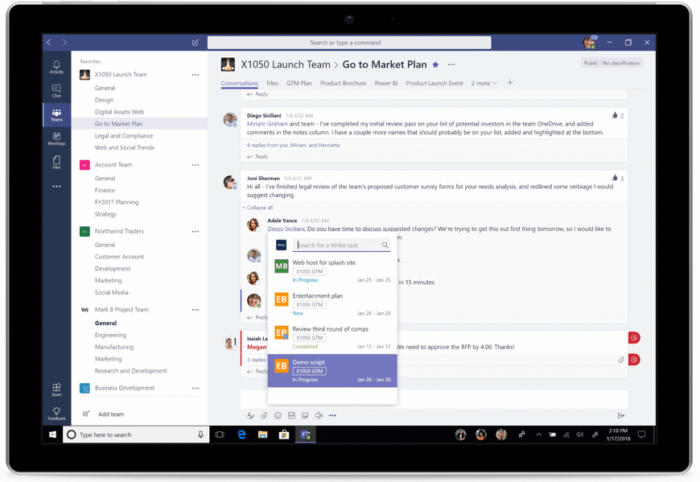Microsoft added a raft of new features to its Teams group chat platform this week, making it easier to interact with third-party apps and find new services through an app directory. The update, Microsoft said, is its biggest single release of new functionality since Teams launched last year.
The launch of the Teams app store means it is now possible to search and discover apps and services to integrate with the chat platform. Users can find apps by searching by name, category or integration type, such as bots. The move brings Teams in line with rival Slack, which launched its own app directory in 2015.
A personal app view puts the most commonly accessed applications at a user’s fingertips and highlights items that have been assigned to them - whether that be Microsoft tools such as Planner or third-party applications like Jira Cloud. Also included in the view is a new app – dubbed Who – that lets users search for people within their organization by name or topic.
Microsoft has also made it easier for users to control apps from within Teams and take quick actions directly from the command box, which has been moved to the top of the screen. Users can, for instance, search for information in an app, such as an image in Adobe Creative Cloud, and insert the results into a Teams conversation.
And slash commands shortcuts allow users to perform quick actions, such as setting their Teams status to ‘away’ by typing ‘/ away’ in the command box, or to quickly add a colleague to a team. Additional command functions are also in the works, Microsoft said, including the ability to create a task in a third-party project management app.
Alan Lepofsky, vice president and principal analyst at Constellation Research, said the new features help bolster Microsoft’s vision of Teams “as the hub for all the Office 365 apps as well as third party integrations.
“No one needs ‘yet another chat app,’” he said, "but if an enterprise messaging client can provide noticeable additional value to a business process, then people will really start to adopt it.”
Raul Castañón-Martínez, senior analyst at 451 Research, said the ability to work more effectively with other applications from within Teams “closes a gap” with vendors like Slack and Atlassian.
“This is something that Slack and Atlassian are particularly good at and have a gained a lead with the number of integrations they provide,” he said.
Castañón-Martínez added that Microsoft is “actually going a step further” than its competitors by providing employees with easy access to the apps their employer assigned to them and the ability to access Microsoft Graph with the Who app.
“These features can help Microsoft defend its position, given that they leverage its existing market footprint,” he said.
Microsoft clearly has big plans for Teams as the central communications tool in Office 365, effectively replacing Skype for Business over time. Although there are plans to add call control features – i.e. hold, call forwarding and voicemail – Teams currently falls short in unified communications capabilities.
“Even with the features that are coming out this year it is still not close to becoming a replacement for a phone system,” he said.
Nevertheless, as a collaboration tool, Teams is now “pretty much up to par with Slack; even ahead in some areas,” Castanon-Martinez said.






